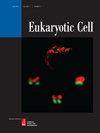A Novel Type Pathway-Specific Regulator and Dynamic Genome Environments of a Solanapyrone Biosynthesis Gene Cluster in the Fungus Ascochyta rabiei.
引用次数: 16
Abstract
ABSTRACT Secondary metabolite genes are often clustered together and situated in particular genomic regions, like the subtelomere, that can facilitate niche adaptation in fungi. Solanapyrones are toxic secondary metabolites produced by fungi occupying different ecological niches. Full-genome sequencing of the ascomycete Ascochyta rabiei revealed a solanapyrone biosynthesis gene cluster embedded in an AT-rich region proximal to a telomere end and surrounded by Tc1/Mariner-type transposable elements. The highly AT-rich environment of the solanapyrone cluster is likely the product of repeat-induced point mutations. Several secondary metabolism-related genes were found in the flanking regions of the solanapyrone cluster. Although the solanapyrone cluster appears to be resistant to repeat-induced point mutations, a P450 monooxygenase gene adjacent to the cluster has been degraded by such mutations. Among the six solanapyrone cluster genes (sol1 to sol6), sol4 encodes a novel type of Zn(II)2Cys6 zinc cluster transcription factor. Deletion of sol4 resulted in the complete loss of solanapyrone production but did not compromise growth, sporulation, or virulence. Gene expression studies with the sol4 deletion and sol4-overexpressing mutants delimited the boundaries of the solanapyrone gene cluster and revealed that sol4 is likely a specific regulator of solanapyrone biosynthesis and appears to be necessary and sufficient for induction of the solanapyrone cluster genes. Despite the dynamic surrounding genomic regions, the solanapyrone gene cluster has maintained its integrity, suggesting important roles of solanapyrones in fungal biology.



一种新型途径特异性调控因子和茄碱酮生物合成基因簇的动态基因组环境
次级代谢物基因通常聚集在一起,位于特定的基因组区域,如亚端粒,这可以促进真菌的生态位适应。茄碱酮是真菌占据不同生态位时产生的有毒次生代谢物。对子囊菌Ascochyta rabiei的全基因组测序发现,一个solanapyrone生物合成基因簇嵌入在端粒近端富含at的区域,并被Tc1/ mariner型转座元件包围。solanapyrone集群的高at富集环境可能是重复诱导的点突变的产物。在茄奈酮簇的侧翼区域发现了几个次级代谢相关基因。尽管茄奈酮簇似乎对重复诱导的点突变具有抗性,但簇附近的P450单加氧酶基因已被这种突变降解。sol1 ~ sol6 6个茄茄酮簇基因中,sol4编码一种新型Zn(II)2Cys6锌簇转录因子。sol4的缺失导致solanapyrone的产生完全丧失,但不影响生长、产孢或毒力。sol4缺失和过表达突变体的基因表达研究划定了solanapyrone基因簇的界限,并揭示了sol4可能是solanapyrone生物合成的特异性调节剂,并且似乎是诱导solanapyrone基因簇的必要和充分条件。尽管周围的基因组区域是动态的,但solanapyrone基因簇保持了其完整性,这表明solanapyrone在真菌生物学中的重要作用。
本文章由计算机程序翻译,如有差异,请以英文原文为准。
求助全文
约1分钟内获得全文
求助全文
来源期刊

Eukaryotic Cell
生物-微生物学
自引率
0.00%
发文量
0
审稿时长
1 months
期刊介绍:
Eukaryotic Cell (EC) focuses on eukaryotic microbiology and presents reports of basic research on simple eukaryotic microorganisms, such as yeasts, fungi, algae, protozoa, and social amoebae. The journal also covers viruses of these organisms and their organelles and their interactions with other living systems, where the focus is on the eukaryotic cell. Topics include: - Basic biology - Molecular and cellular biology - Mechanisms, and control, of developmental pathways - Structure and form inherent in basic biological processes - Cellular architecture - Metabolic physiology - Comparative genomics, biochemistry, and evolution - Population dynamics - Ecology
 求助内容:
求助内容: 应助结果提醒方式:
应助结果提醒方式:


